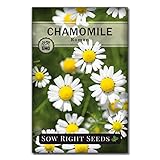Table of Contents
Roman chamomile was known because it was cultivated in Rome during the 16th and 17th centuries. There is no proof that ancient Romans or Greeks knew the plant. Despite its properties being similar to German Chamomile, Roman chamomile has preserved its personality and place in phytotherapeutic science.
- USDA Certified Organic
- 100% Natural Chamomile Flowers
- Naturally caffeine-free
- Food grade
- 1.76 oz/50g

Roman Chamomile Scientific Facts
- Scientific Name – Anthemis nobilis L.
- Other Names – Chamomile, garden chamomile, ground apple, low chamomile, whig plant.
- French – Camomile romaine.
- Spanish – Manzanilla romana.
- Environment – Farmed fields in western Europe. The plant also grows in areas of America.
- Description—Roman chamomile is a Vigorous plant of the Compositae family that grows from 10 to 30 cm high. It is shorter and more common than German chamomile. Roman chamomile has finely divided leaves and flowers, similar to German chamomile but with a more intense aroma.
- Parts of the plant are used medicinally, such as flower clusters or flower heads.
Roman Chamomile Benefits

The essence of Roman chamomile contains chamazulene, which has anti-inflammatory properties, several esters (organic compounds), and a bitter component with digestive and carminative (helps expulsion intestinal gas) properties. It also contains coumaric and flavonoid substances with antispasmodic properties. The plant also has emmenagogue (stimulates and balances menstruation) and antirheumatic properties. It is applied internally in the treatment of:
- Digestive disorders (its most important application) – dyspepsia, flatulence, nausea, upset stomach.
- Intestine, gall bladder, or liver colics because of its antispasmodic properties.
- Menstrual pains.
Externally applied, it is used for:
- Rheumatism – in massages and lotions.
- To heal wounds, apply compresses to the skin.
- Eye baths – as eyedrops.

How to use Roman Chamomile
- Infusion, with 5 to 10 grams of flower heads per liter of water. Drink up to six cups daily.
- Powder – The dose varies from two to 10 grams a day. Prepare it in a water solution, and add some honey.
- Essence – The recommended dose is from two to four drops daily.
- Compresses, soaked in a decoction made with 20 to 30 grams of flower heads per liter of water. The cloth is then applied to the skin.
- Eye bath with the same decoction.
- Lotion on the skin, with the plant’s essence dissolved in alcohol.
Frequently Asked Questions
I’ve read about Roman chamomile’s relaxing effects, but how does it work within the body?
Roman chamomile contains compounds like apigenin and bisabolol. These act on specific brain receptors (GABA receptors) to reduce anxiety and promote sleepiness.
Can Roman chamomile truly aid with digestive problems?
Evidence suggests yes! It seems to have antispasmodic effects on the digestive tract, helping to reduce bloating, cramps, and indigestion. Its anti-inflammatory properties may also soothe mild irritation in the stomach and intestines.
Are studies explicitly looking at Roman chamomile for Irritable Bowel Syndrome (IBS)?
While research is ongoing, there are some promising small-scale studies. One pilot study indicated that a combined herbal preparation, including the plant, significantly reduced IBS symptoms compared to a placebo group.
I use Roman chamomile topically for irritated skin. Is there science behind this?
Yes. Its anti-inflammatory effects, along with potential wound-healing properties, are supported by research. It’s been shown to help with conditions like mild eczema when applied as a cream or compress.
Can Roman chamomile essential oil ease muscle pain?
It’s possible. Roman chamomile’s antispasmodic and anti-inflammatory effects might relieve muscle tension and soreness when used in massage oils or aromatherapy. However, more robust studies are needed in this area.
I know about drinking chamomile tea. Are there other ways to use it?
Yes! Consider:
– Inhalation: Adding essential oil to a diffuser for anxiety reduction.
– Topical: Infused ointments or diluted oil for skin conditions.
– Capsules: Supplements with standardized Roman chamomile extract.
I’m interested in the potential anticancer effects. Is there solid research on this?
This area is still under investigation. Lab studies have demonstrated that certain compounds in Roman chamomile might inhibit the growth of some cancer cell lines. However, translating these effects to humans requires extensive research.
Is Roman chamomile safe for everyone?
While generally considered safe, remember:
– Allergies to the Asteraceae family (like ragweed) might trigger reactions.
– It can interact with specific medications, so consult your doctor.
– Pregnancy/breastfeeding: Avoiding internal use during these periods is best.
How much Roman chamomile is recommended for health benefits?
Dosage recommendations vary depending on the condition and form of chamomile used (tea, capsules, etc.). It’s crucial to check with a healthcare professional for individualized guidance.
Where can I find reliable information about Roman chamomile?
Reputable sources include:
(NCCIH)
University medical centers (e.g., Mount Sinai, Cleveland Clinic).
Scientific journals focusing on herbal medicine.
Important Note: Always consult your doctor before incorporating Roman chamomile into your health routine.
DISCLAIMER: All content on this website is presented solely for educational and informational objectives. Do not rely on the information provided as a replacement for advice, diagnosis, or treatment from a qualified medical expert. If you are pregnant, nursing, or have any preexisting medical concerns, talk to your doctor before using any herbal or natural medicines.
REFERENCES
- George D. Pamplona-Roger, M.D. “Encyclopedia of Medicinal Plants.” George D. Pamplona-Roger, M.D. Encyclopedia of Medicinal Plants. Ed. Francesc X. Gelabert. Vols. 1 San Fernando de Henares: Editorial Safeliz, 2000. 350. Print.
- National Institutes of Health: https://www.ncbi.nlm.nih.gov/pmc/articles/PMC10766393/
- WebMD: https://www.webmd.com/diet/health-benefits-chamomile
- Mount Sinai: https://mountsinaibio.com/
Last update on 2024-07-21 / Affiliate links / Images from Amazon Product Advertising API






